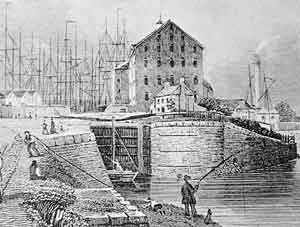John Jones to 1825
John
Jones lived in a house on the site where the Canal Office was later
built. During his time, the canal was not fully open, and the lock
provided the only access to the basin. In 1819, he was relieved
of his toll collecting duties because he was not performing properly,
and six years later he was dismissed for frequently being intoxicated.
Thomas Cox 1825-1840
Thomas
Cox was the first resident of the house beside the lock which was
built in 1826. As well as collecting tolls on traffic through the
lock, he was also responsible for collecting wharfage dues on goods
left on the public wharves around the basin. Due to ill health,
he retired with a small pension, aged 73.
Richard Goscombe 1840-1871
Richard
Goscombe had been sergeant in charge of the Canal Company's watchmen.
He served as lock keeper for over 30 years before retiring with
a pension, aged 75.
Henry Long 1871-1880
Henry
Long had been bridgeman at Hempsted. In his first year a new office
was built at the north end of the lock house, replacing a former
office at the south end. In 1880, the Canal Company management became
concerned about some irregularities in Henry Long's accounts, and
he immediately admitted that he had not recorded all the money he
had received. He was taken before the magistrates on a token charge
of retaining £6 paid when the Severn Commission's dredger
had passed through the lock after repairs in the dry dock, and he
was sentenced to three months hard labour.
Charles Edwards 1881-1916
Charles
Edwards was in charge when the lock was modified in 1892 to accommodate
larger barges. Previously, vessels had passed through two locks
separated by an intermediate set of gates, the recesses of which
can still be seen. As part of a larger scheme to improve the Severn
navigation, the lower chamber and part of the
upper chamber was deepened so that larger barges could be passed
through. In the same year, the lock house was enlarged by adding
a second storey to the rear part of the house. Evidently inspired
by the sight of the vessels that visited the docks, Charles Edwards
bought the schooner Flying Dutchman, 47 tons reg, but sadly
she was lost with all hands on a voyage from Liverpool to Bridgwater
in February 1902. Later, after 35 years as lock keeper, he died
in service aged 63.
Tomas Pilkington 1917-1946
Thomas
Pilkington was toll clerk at Gloucester before being promoted to
lock keeper. During his time, there was a huge growth in traffic
on the river from 139,518 tons of cargo in 1925 to 435,934 tons
in 1945, mainly due to the dramatic development of the transport
of petroleum products. By the time of his retirement, he had been
lock keeper for almost 30 years.
Colin Turner 1947-1957
Soon
after Colin Turner took over, the lock and lock house were threatened
by the biggest river flood since the canal was constructed. The
stop gates at the river end of the lock were closed to prevent the
dock being flooded, and as the water level continued to rise, additional
planks were fitted on top of the gates and sandbags were laid on
top of the stonework. In the event, the level peaked just below
the top of the stonework and the flood-water was just kept out of
the dock. Colin Turner became a manager in the Dock Office.
Sidney Eades 1958-1962
During
Sidney Eades's time as lock keeper, the number of tanker and dry-cargo
barges passing though each day was so great that delays became significant.
To ease the bottleneck, a new road bridge was built across the lock,
only the second aluminium bridge in the country, and hydraulic equipment
was installed to speed up operation of the lock. With a further
increase in traffic expected, plans were drawn up for a second lock
which would have required pulling down part of the North Warehouse,
but in the event this was not required.
John Jones 1962-1990
During
the 1960s, there was a dramatic run-down in the transport of goods
by water due to strong competition from rail and road transport,
and daily life for John Jones became much easier than for his predecessors.
The decline in commercial traffic was to some extent offset by an
increasing use of the lock by pleasure craft, and this set the pattern
for the future.
 Recent
Years Recent
Years
Although barges carrying
wheat to Healing's Mill at Tewkesbury continued into the 1990s and
some aggregate traffic is expected to start in 2005, the main use
of Gloucester Lock is now by pleasure craft. Rather than paying
for each passage, pleasure craft pay an annual licence fee administered
nationally, and it is only very occasionally that the lock keeper
has to collect money when a boat with only a river licence wishes
to use the canal.
Since John Jones retired, the lock
keepers have been Pat Burke to 1995, John Brand to 2003, Michelle
Crowther to 2004, Johnathan Chater to 2007 and currently Simon Clutterbuck.
Lock keepers are no longer expected to live in the lock house, which
has been sold.
Principal sources: Minute books of the Canal Co in the National
Archives; Electoral Registers; Embezzlement GC 8 Jan 1881; Shipwreck
GJ 8 Mar 1902; Tonnages D2460 Box 53. |
 Gloucester
Lock Keeper
Gloucester
Lock Keeper Recent
Years
Recent
Years